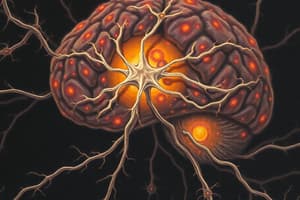Podcast
Questions and Answers
What is the primary function of oligodendrocytes?
What is the primary function of oligodendrocytes?
- To absorb nutrients for the neuron
- To form myelin sheaths around axons (correct)
- To stimulate muscle contraction
- To transmit signals between neurons
Which structure of the brain is primarily associated with coordinating fine motor skills?
Which structure of the brain is primarily associated with coordinating fine motor skills?
- Thalamus
- Hippocampus
- Cerebellum (correct)
- Cerebrum
Which neurotransmitter plays a significant role in mood regulation and is often linked with feelings of happiness?
Which neurotransmitter plays a significant role in mood regulation and is often linked with feelings of happiness?
- Dopamine (correct)
- Norepinephrine
- Acetylcholine
- GABA
Which part of the brain is responsible for processing sensory information before it reaches the cerebral cortex?
Which part of the brain is responsible for processing sensory information before it reaches the cerebral cortex?
What is the role of the medulla oblongata in the brainstem?
What is the role of the medulla oblongata in the brainstem?
What is the primary function of the hippocampus?
What is the primary function of the hippocampus?
Which type of neurotransmitter is most associated with inhibiting neuronal activity?
Which type of neurotransmitter is most associated with inhibiting neuronal activity?
Which system is primarily responsible for the rapid fight-or-flight response?
Which system is primarily responsible for the rapid fight-or-flight response?
What primary role do interneurons play in the nervous system?
What primary role do interneurons play in the nervous system?
Which of the following is not a recognized function of the cerebrum?
Which of the following is not a recognized function of the cerebrum?
Which neurotransmitter is prominently known for its role in reward pathways in the brain?
Which neurotransmitter is prominently known for its role in reward pathways in the brain?
What structure directly connects the brain to the spinal cord?
What structure directly connects the brain to the spinal cord?
Which type of reflex is specifically managed by the spinal cord without direct involvement of the brain?
Which type of reflex is specifically managed by the spinal cord without direct involvement of the brain?
Which part of the nervous system primarily regulates digestive processes?
Which part of the nervous system primarily regulates digestive processes?
What is the primary excitatory neurotransmitter found in the central nervous system?
What is the primary excitatory neurotransmitter found in the central nervous system?
What are the two main divisions of the nervous system?
What are the two main divisions of the nervous system?
Which of the following is an incorrect function of the medulla oblongata?
Which of the following is an incorrect function of the medulla oblongata?
Which system is the hippocampus primarily associated with?
Which system is the hippocampus primarily associated with?
What is the primary function of the thalamus?
What is the primary function of the thalamus?
Which layer of the meninges is directly attached to the brain tissue?
Which layer of the meninges is directly attached to the brain tissue?
Which structure in the brain is primarily responsible for integrating sensory information and spatial awareness?
Which structure in the brain is primarily responsible for integrating sensory information and spatial awareness?
Which brain structure is crucial for regulating long-term memory and emotional responses?
Which brain structure is crucial for regulating long-term memory and emotional responses?
What is the role of cerebrospinal fluid (CSF)?
What is the role of cerebrospinal fluid (CSF)?
Which area of the brain is specifically associated with speech and language production?
Which area of the brain is specifically associated with speech and language production?
Flashcards are hidden until you start studying
Study Notes
Nervous System Functions
- The nervous system links humans with the external world, coordinating body system activities.
- With the endocrine system, the nervous system maintains homeostasis.
- The nervous system includes the central nervous system (CNS) and the peripheral nervous system (PNS).
CNS Components
- The CNS consists of the brain and the spinal cord.
PNS Components
- The PNS consists of the cranial nerves and the spinal nerves.
Cell Types in Nervous Tissue
- The two main types of cells in nervous tissue are glial cells and neurons.
- Glial cells provide support and protection for neurons, and new glial cells are formed after birth.
- Neurons are specialized cells that transmit signals in the nervous system.
The Medulla Oblongata
- The medulla oblongata controls heart rate, respiration, and swallowing.
Brain's Fuel Source
- The brain requires a constant supply of oxygen and glucose.
Hypothalamus Function
- The hypothalamus regulates body temperature, hunger, thirst, and water balance.
Thalamus Function
- The thalamus relays sensory messages to the cerebral cortex.
Cerebellum Function
- The cerebellum coordinates muscle movements, balance, and posture.
Cerebral Cortex
- The cerebral cortex is the outermost layer of the cerebrum.
Central Sulcus
- The central sulcus separates the frontal and parietal lobes.
Primary Motor Cortex
- The primary motor cortex is located in the frontal lobe and controls voluntary movement.
Wernicke's and Broca's Areas
- Wernicke's area is responsible for speech comprehension.
- Broca's area is responsible for speech production.
Occipital Lobe Function
- The occipital lobe processes visual information.
Hippocampus
- The hippocampus is part of the limbic system and plays a role in memory and learning.
Parietal Lobe Function
- The parietal lobe processes sensory information and is involved in spatial awareness.
Amygdala Function
- The amygdala is important for long-term memory and emotions.
Meninges
- The meninges are membranes that protect the brain and spinal cord.
- The pia mater is the innermost layer of the meninges.
Spinal Cord Extension
- The spinal cord extends from the medulla oblongata to the L-2 vertebra.
Cerebrospinal Fluid Production
- Cerebrospinal fluid is produced in the ventricles of the brain.
Hypothalamus as a Link
- The hypothalamus links the nervous system to the endocrine system.
Medulla Oblongata Reflex Actions
- The medulla oblongata is involved in reflex actions such as swallowing and vomiting.
Autonomic Nervous System Divisions
- The autonomic nervous system is divided into the sympathetic and parasympathetic systems.
Neuron Protection
- The myelin sheath protects the neuron's cell body.
Myelin Sheath Function
- The myelin sheath increases the speed of electrical impulses.
Neuromuscular Junction Neurotransmitter
- Acetylcholine is released at neuromuscular junctions to stimulate muscle contraction.
Most Abundant CNS Neurotransmitter
- Glutamate is the most abundant neurotransmitter in the CNS.
GABA Function
- GABA is an inhibitory neurotransmitter linked to feelings of relaxation and sleepiness.
Medulla Oblongata Function
- The medulla oblongata controls involuntary actions such as breathing and heartbeat.
Parasympathetic Nervous System Function
- The parasympathetic nervous system is responsible for the rest-and-digest response.
Blood-Brain Barrier Formation
- Astrocytes are involved in forming the blood-brain barrier.
Spinal Cord Function
- The spinal cord transmits signals between the brain and the rest of the body.
Hippocampus Function
- The hippocampus is primarily associated with memory and learning.
Cerebellum Function
- The cerebellum coordinates voluntary movements.
GABA Neurotransmitter Type
- GABA is an inhibitory neurotransmitter.
Hypothalamus Regulation
- The hypothalamus regulates the endocrine system.
Peripheral Nervous System Components
- The brain is not part of the peripheral nervous system.
Voluntary Movement Control
- The somatic nervous system is primarily responsible for voluntary movement.
Interneurons Function
- Interneurons transmit impulses from sensory neurons to motor neurons.
Cerebrum Functions
- The cerebrum is involved in coordination of movement, sensory processing, decision-making, and memory storage, but not in reflex actions.
Dopamine -"Reward" Chemical
- Dopamine is known as the "reward" chemical in the brain.
Brain-Spinal Cord Connection
- The medulla oblongata connects the brain to the spinal cord.
Spinal Reflex
- A spinal reflex is controlled by the spinal cord without involving the brain.
Digestive System Control
- The parasympathetic nervous system controls digestive processes.
Main Excitatory Neurotransmitter
- Glutamate is the main excitatory neurotransmitter in the CNS.
Studying That Suits You
Use AI to generate personalized quizzes and flashcards to suit your learning preferences.





